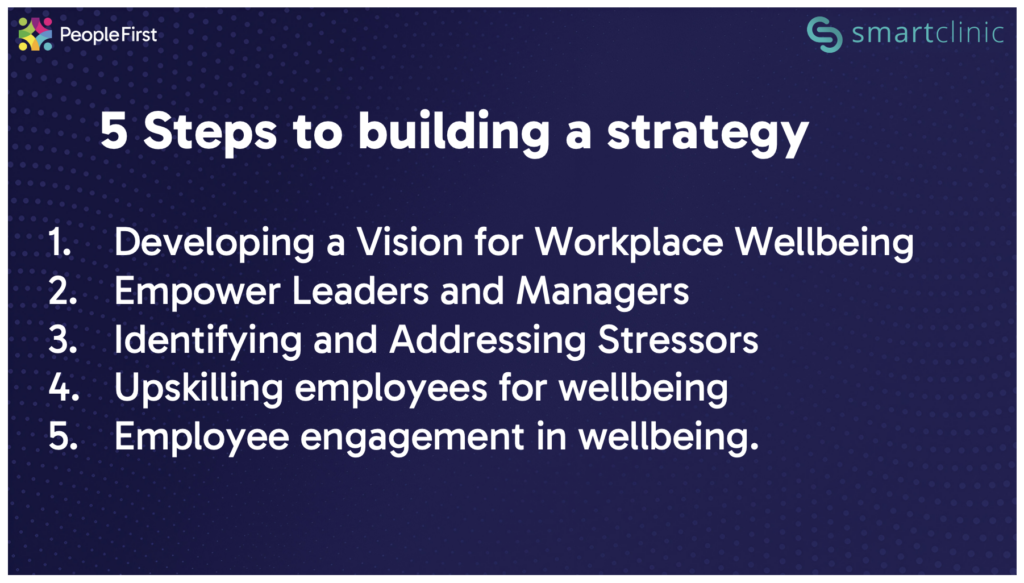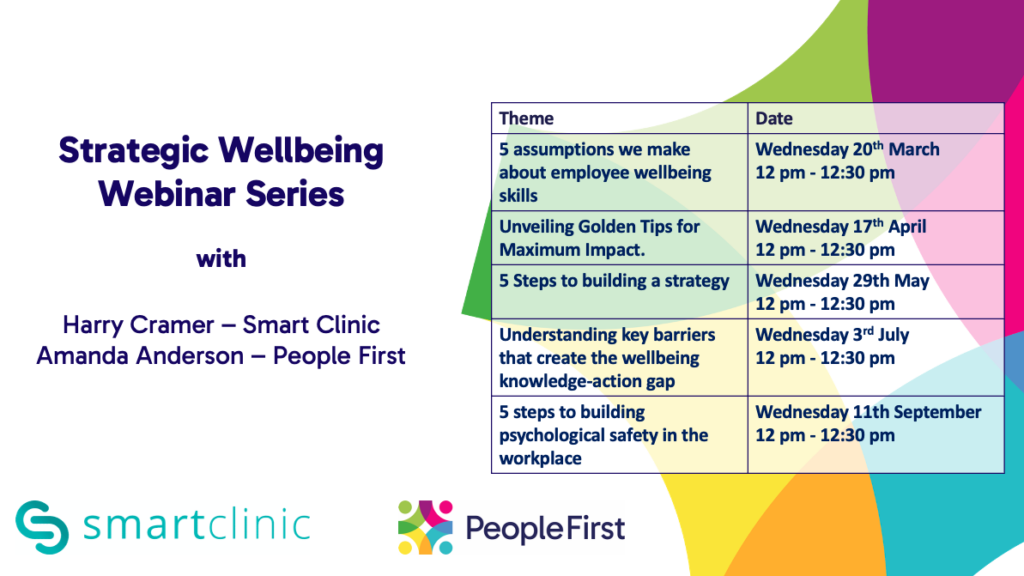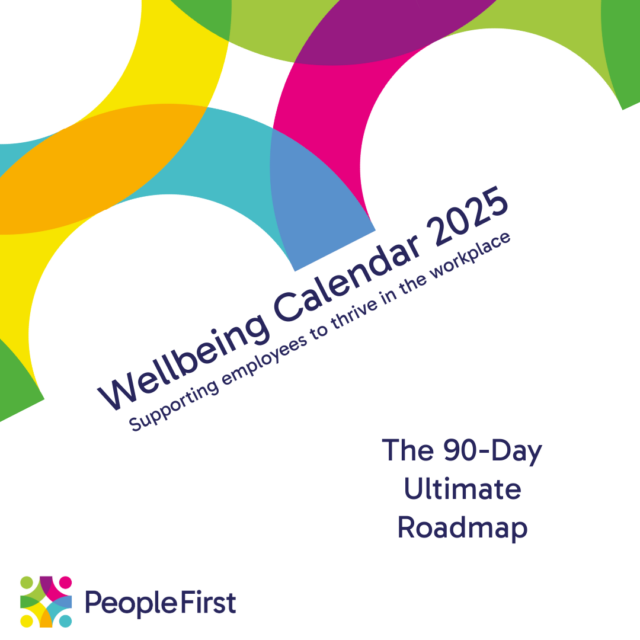
05 June 2024
5 Steps to building a strategy
Last week was our third webinar in the strategic wellbeing series in association with Smart Clinic looked at 5 steps to building a strategy. If you missed it, you can catch up on the recording here. A summary of the webinar is below.

Employee wellbeing is the cornerstone of a healthy, thriving workplace. When employees feel supported, valued, and mentally and physically well, they’re more engaged, productive, and motivated. These steps will give you a glimpse of the range of support we offer organisations, taken from our programmes designed to support you every step of the way in creating and implementing your desired workplace wellbeing culture.
Don’t leave employee wellbeing to chance. Building a strategy that ensures employees can thrive is vital.
Step 1: Developing a Vision for Workplace Wellbeing
When we start our support for building a strategy, we begin by creating a vision of what great wellbeing looks like for your organisation. During the webinar, we took a moment to stop, pause, and reflect on what this vision might look like through a Visualisation Exercise.
Here are five reflection questions to guide your thoughts. Jot down your ideas about what workplace wellbeing means to you. Close your eyes and imagine your ideal workplace environment in terms of wellbeing:
- What does a typical day in your ideal workplace look like in terms of wellbeing?
- How do you feel emotionally and mentally in your ideal workplace?
- What specific activities contribute most to your sense of wellbeing at work?
- In your ideal workplace, how do you navigate challenges or setbacks while maintaining your wellbeing?
- What values and principles are most important to you when it comes to workplace wellbeing?
These questions are designed to prompt reflection and help you explore your vision for workplace wellbeing. By knowing what great wellbeing looks like for your organisation, you can effectively create and implement a strategy that fosters a supportive and thriving workplace.
Step 2: Empowering Leaders and Managers
A pervious webinar explored the role of managers in creating a supportive environment, examining eight key areas. Building a strategy around empowering your leaders and managers is a must. If you missed it, I encourage you to watch the recording or read the blog feature.
It’s essential to recognise the pivotal role that leaders and managers play. Supportive managers wear many hats:
- Emotional Support: They create a safe space where team members can express themselves freely and feel heard and understood.
- Communication and Collaboration: They break down silos, build bridges across departments, and ensure that ideas are shared, challenges are overcome, and victories are celebrated together.
- Conflict Resolution: They turn disagreements into opportunities for growth and understanding, ensuring fairness and respect for all involved.
- Recognition and Feedback: They nurture a culture of appreciation and continuous improvement.
How good are your leaders and managers at creating a culture of wellbeing? The success of supportive management requires intention, dedication, and investment in manager wellbeing training. By investing in training for skills such as communication, conflict resolution, and emotional intelligence, you can empower managers to effectively prioritise employee wellbeing. Equipping them with the skills and resources they need builds a solid foundation for your workplace wellbeing strategy.
Step 3: Identifying and Addressing Stressors
We advocate a proactive approach to wellbeing by offering preventative solutions and support. Building a strategy around understanding the origins of stress is essential for employers to manage and mitigate it.
Proactive employers conduct regular audits and assessments to pinpoint stressors, demonstrating a commitment to nurturing a supportive workplace culture. Ask yourself: When was the last time you explored the main issues contributing to stress in your workplace? What do your employees say?
Engaging with employees is crucial. Their feedback provides valuable insights into the sources of stress they face daily. Open communication channels and anonymous surveys can help gather honest feedback, enabling you to act on it.
We’ve crafted a quick employer reference guide to help you navigate this journey, highlighting ten common themes that contribute to workplace stress and including reflection questions to identify stressors within them. For instance, if workload is a major stressor, consider strategies such as redistributing tasks or providing time management training for your employees. If workplace relationships are a concern, initiatives like team-coaching and conflict resolution training could be beneficial.
By proactively identifying and addressing stressors, you can create a healthier, more supportive workplace environment. This not only enhances employee wellbeing but also boosts productivity and morale.
Step 4: Up-skilling Employees for Wellbeing
Our first webinar explored wellbeing assumptions, highlighting the need for employees to have the skills to support their own wellbeing. For step four, we recommend building a strategy that introduces wellbeing training programme to your professional development programmes. This ensures employees not only have the necessary skills but also know how to apply them when needed.
A strategic approach is to provide wellbeing training as part of their onboarding programme. This ensures that from day one, employees are equipped with the tools and knowledge to prioritise their wellbeing. We offer a series of wellbeing workshops designed to educate employees about various wellbeing and mental health issues, foster open dialogue to reduce stigma, equip employees with practical coping strategies, and educate them on recognising signs of distress in themselves and others.
Incorporating wellbeing training into your strategy ensures that employees have the necessary skills and knowledge to prioritise their mental health and wellbeing, creating a supportive and resilient workforce that thrives both personally and professionally.
Step 5: Employee Engagement in Wellbeing Initiatives
For step five, we invite you to explore ways to actively engage your employees in wellbeing initiatives. Employee engagement is crucial for creating a supportive and thriving workplace culture. Here are a couple of ideas on how to do it:
- Establish a Wellbeing Committee: This dedicated team will champion employee wellbeing initiatives, gather feedback, and tailor strategies to meet the unique needs of your workforce. The committee can organise events, monitor the success of initiatives, and ensure that wellbeing remains a priority.
- Conduct Regular Wellbeing Reviews: Use surveys, focus groups, or one-on-one meetings to assess employee wellbeing, identify areas of concern, and evaluate the effectiveness of existing initiatives. This feedback is invaluable for informed decision-making and prioritising actions. Regular reviews help keep your strategy dynamic and responsive to employee needs.
- Invest in Mental Health First Aid and Wellbeing Champions: These roles play a vital part in workplaces by raising awareness about mental health issues, providing peer support, and identifying and addressing workplace issues. They lead by example, promoting healthy habits and positive behaviours among peers. If you haven’t considered mental health first aiders or wellbeing champions, now is the time to explore this as part of your strategy. These roles can significantly enhance your workplace culture and provide much-needed support to employees.
If you already have these roles in place, please encourage these key personnel to attend our networking group ‘The Exchange.’ ‘The Exchange’ is our online community network that provides a supportive and collaborative environment for Mental Health First Aiders (MHFA), Mental Health Champions, and Wellbeing Champions. It offers a valuable opportunity for members to exchange knowledge, strategies, and experiences, as well as share successful practices.

Quick Summary
- Develop a Vision for Workplace Wellbeing: Start by envisioning what great wellbeing looks like for your organisation, using a visualisation exercise to reflect on key aspects of an ideal workplace environment.
- Empower Leaders and Managers: Acknowledge the vital role of leaders and managers in fostering wellbeing, ensuring they are trained in emotional support, communication, conflict resolution, and other essential skills.
- Identify and Address Stressors: Conduct regular audits to identify and mitigate stressors in the workplace, using employee feedback to create and implement effective strategies.
- Upskill Employees for Wellbeing: Introduce wellbeing training programmes during onboarding and through continuous workshops, educating employees on mental health issues and practical coping strategies.
- Engage Employees in Wellbeing Initiatives: Establish a Wellbeing Committee, conduct regular reviews, and invest in Mental Health First Aiders and Wellbeing Champions to foster a supportive culture and actively involve employees in wellbeing efforts.
Let’s make wellbeing a priority for everyone. Thank you for your commitment to fostering a healthier, happier workplace.
What is next?
The next webinar explore the key barriers that create the wellbeing knowledge-action gap. To ensure you can access the webinars, please register or sign up for our newsletter to get the latest insights and information directly to your inbox.





